Stablecoin issuers can create digital dollars, but that’s only the beginning. For these tokens to really matter, people must be able to spend them, transfer them, and accept them in everyday life. That’s where the enablers come in, the companies building the rails and forging the partnerships that make stablecoins practical for things like online shopping, merchant payments, and cross-border transfers.
In our previous blog on stablecoin issuers, we looked at the foundations: players like Circle, Tether.io, and Gemini who issue stablecoins and decide how they’re backed. That was the base layer. Without issuers, there would be no stablecoins.
But the bigger question is: what happens once those coins exist? Who ensures they don’t just sit in wallets but actually move through shops, businesses, and transactions? That’s the role of the enablers, turning stablecoins from static tokens into money that works.
In this report, we shift the focus to five of the most important enablers today: AlchemyPay, MoonPay, Ramp, Coinbase, and BitPay. What makes them interesting is not just their products, but how they grow. We look at their velocity (the pace of expansion), their go-to-market strategies, their key partnerships and licensing footprints, and even the kinds of open roles they’re hiring for as signals of where they’re heading next.
Headcount Growth: Who’s Scaling the Fastest?
Stablecoin enablers are not only growing in market presence, but they’re also scaling their teams rapidly to meet the demand. Headcount tells us two things: how big these firms have become and how fast they’re expanding.
Looking at the past year, the differences are striking:
- Coinbase remains the giant, with 6,204 employees in September 2025, up from 4,661 a year ago. That’s a 33% growth in headcount, impressive for such a large, established player.
- Ramp more than doubled, scaling from 1,069 to 2,516 employees, a 135% surge, making it the fastest-growing team in absolute and relative terms.
- MoonPay also saw solid momentum, expanding from 306 to 401 employees, about a 31% increase, probably fueled by acquisitions like Helio and Meso.
- BitPay, on the other hand, stayed fairly steady, inching from 135 to 144 employees, only a 7% rise, signaling more of a “lean and steady” approach.
- Alchemy Pay barely changed, with 64 employees now versus 64 a year ago, essentially flat, showing that it’s running a very lean model despite serving 173 countries.
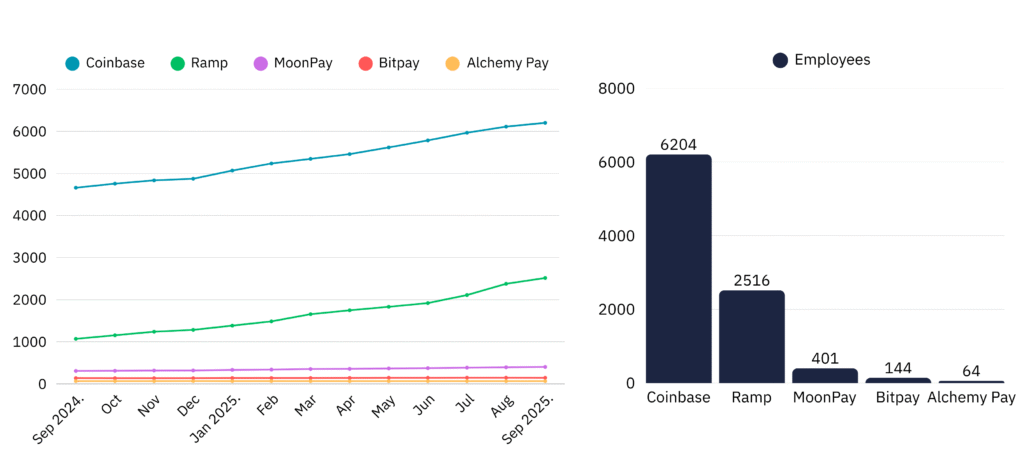
Coinbase
Coinbase is by far the largest player among stablecoin enablers, with 6,204 employees and an impressive 328 open roles. Its hiring spread reflects both the scale of its payments ambitions (e.g., Shopify USDC integration) and the need to maintain regulatory and operational resilience across dozens of markets.
Open roles:
- Engineering & Data dominates (178 roles, 31%): Coinbase continues to invest in the technical foundation of its payments, exchange, and blockchain ecosystem.
- Customer Experience (60 roles): the second-largest area, showing the importance of supporting merchants and retail customers as stablecoin usage scales.
- Finance & Accounting (19) and Product (15): key functions ensuring operational discipline and product innovation.
- Security & Privacy (14): essential for safeguarding assets and maintaining trust as payment volumes grow.
- Other functions: Design (12), Biz & Partnerships (9), Legal & Compliance (9), HR (4), Policy (4), Sales (3), IT (3), Operations (2), Marketing (1).
Geography:
- U.S. leads with 192 roles, followed by Canada (72).
- India (21) and UK (18) probably show strong offshore engineering and operations hubs.
- Smaller but strategic hiring in Singapore (8), Ireland (8), Philippines (5), Brazil (3), and Mexico (1).
Coinbase’s hiring reflects a dual priority:
- Technical depth (engineering, product, security) → to keep its infrastructure reliable as it evolves into a mainstream payments processor.
- Customer-facing and regulatory functions (customer support, compliance, policy) → to manage the challenges of operating worldwide in a closely regulated industry.
Compared to Ramp or MoonPay, Coinbase is already global and regulated, so its hiring is about scaling breadth rather than entering new markets. The heavy emphasis on engineering and customer experience suggests Coinbase is preparing to support mass adoption of stablecoins in e-commerce and retail payments. Meanwhile, the distribution of roles across Canada, India, and the Philippines shows how it is building regional hubs to balance costs, compliance, and 24/7 support coverage.
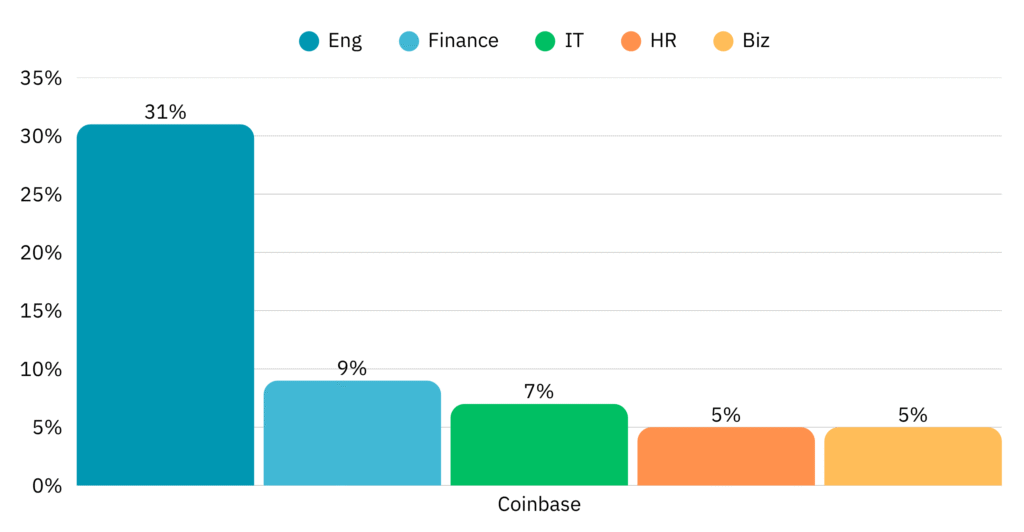
Ramp
Ramp is one of the fastest-growing companies in the stablecoin enabler group, with a team of 2,516 employees and 130 open roles. Unlike Alchemy Pay’s lean approach or MoonPay’s technical concentration, Ramp is hiring broadly across functions, reflecting its ambition to dominate corporate spend management and expand internationally.
Open roles:
- Sales (19%, 23 roles): Ramp is aggressively building its salesforce, signaling a push to win more mid-market and enterprise clients in the B2B space.
- Engineering & Data (17 roles, 14%): strong technical hiring to support its stablecoin-backed corporate card and AI-driven spend tools.
- Marketing (14 roles): heavy investment in awareness and positioning against incumbents like AmEx and SAP Concur.
- Risk (12 roles): notable for a fintech, highlighting Ramp’s focus on compliance and fraud prevention as it enters volatile markets like Latin America.
- Other functions: Design (9), Product (6), Finance (5), HR (4), Biz & Corporate (3), Legal (3), Security (2), Customer Experience (2).
Geography:
- 98% of open roles are in the U.S. & Canada, showing Ramp’s main base remains North America.
- Only 1 role each in Ireland and the UK.
Ramp’s hiring tells the story of a company transitioning from a fast U.S.-focused fintech to a global B2B payments contender. The big bet on sales shows it wants to grab market share quickly, while significant hiring in risk and engineering underscores the dual challenge of scaling innovation and staying compliant in new regions.
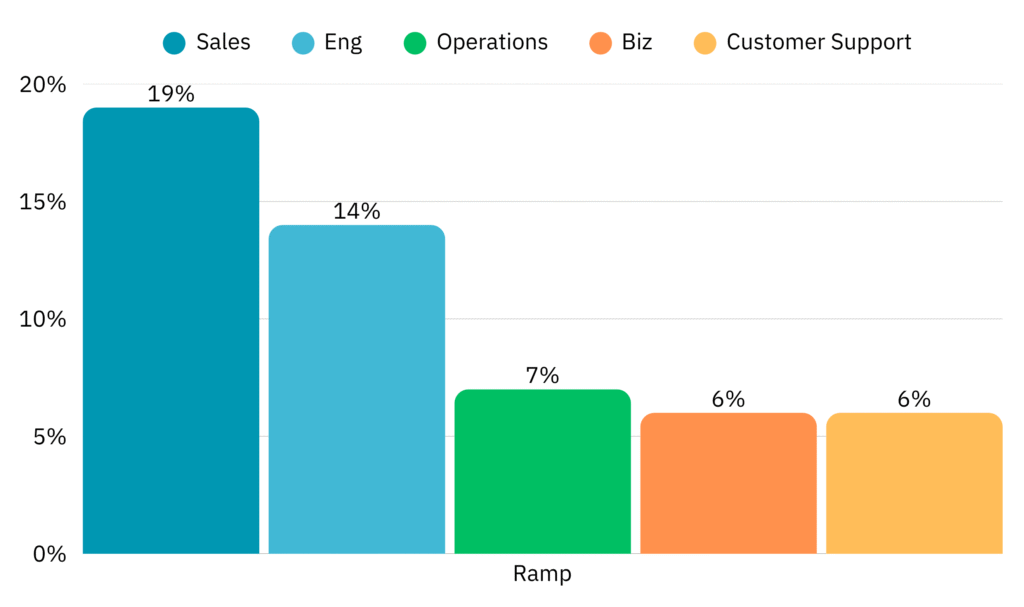
MoonPay
MoonPay is in a different league of hiring compared to Alchemy Pay. With a headcount of 401 employees, it currently has 27 open roles, and every one of them is hybrid or remote, underscoring MoonPay’s global-first, distributed model.
The hiring spread shows where MoonPay’s priorities lie:
- Engineering & Data dominates (32%, 16 roles): MoonPay is investing heavily in technical talent to scale its infrastructure, integrate acquisitions (like Helio and Meso), and support complex partnerships with giants like Mastercard and PayPal.
- Product (3 roles): focused on shaping new payment experiences, such as stablecoin merchant checkout flows.
- Finance and IT (7% each): steady hiring to manage growth and internal systems.
- Legal, Marketing, Customer Experience, Operations, Fraud, HR, Compliance, Design (1 role each): smaller but strategic, suggesting selective scaling in these functions.
MoonPay’s hiring strategy is about deepening its technical core while maintaining a lean presence in business and support functions. This makes sense given its transformation into a global payments network: integrating with Mastercard, scaling on-chain payments, and building a compliant, bank-linked infrastructure all require serious engineering and data muscle.
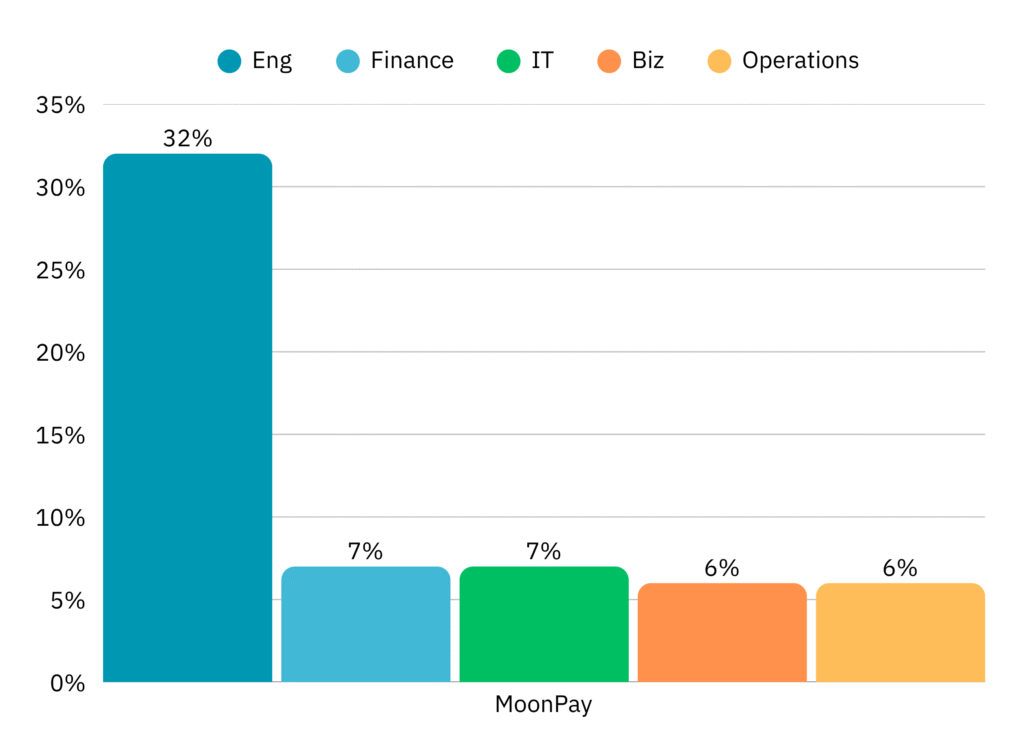
BitPay
BitPay, with a total team size of 144 employees, stands out from the others by showing almost no active expansion in headcount. Currently, the company has just one open role, a Product position based in the USA.
Unlike Coinbase, MoonPay, or Ramp, which are expanding aggressively, BitPay is taking a far more conservative hiring approach, focusing narrowly on improving its product rather than scaling staff.
The historical spread of functions shows how the company’s workforce is distributed:
- Finance (19%) and Engineering (15%) are its largest focus areas, reflecting its dual priorities of payment reliability and technical stability.
- Business (10%) and Sales (6%) indicate limited commercial push.
- Entrepreneurship (6%) reflects roles around strategy and leadership, though not in active expansion.
BitPay’s minimal hiring suggests that it is prioritizing consolidation over growth. With stablecoins already making up the majority of its processed volume, the company may be focused on scaling usage with existing resources and partners (like CatalystPay and PayPal) rather than enlarging its internal team. This contrasts sharply with the others: where Ramp is adding salespeople and Coinbase is hiring globally at scale, BitPay is effectively saying: “We’ve built the rails; now let’s optimize what we have.”
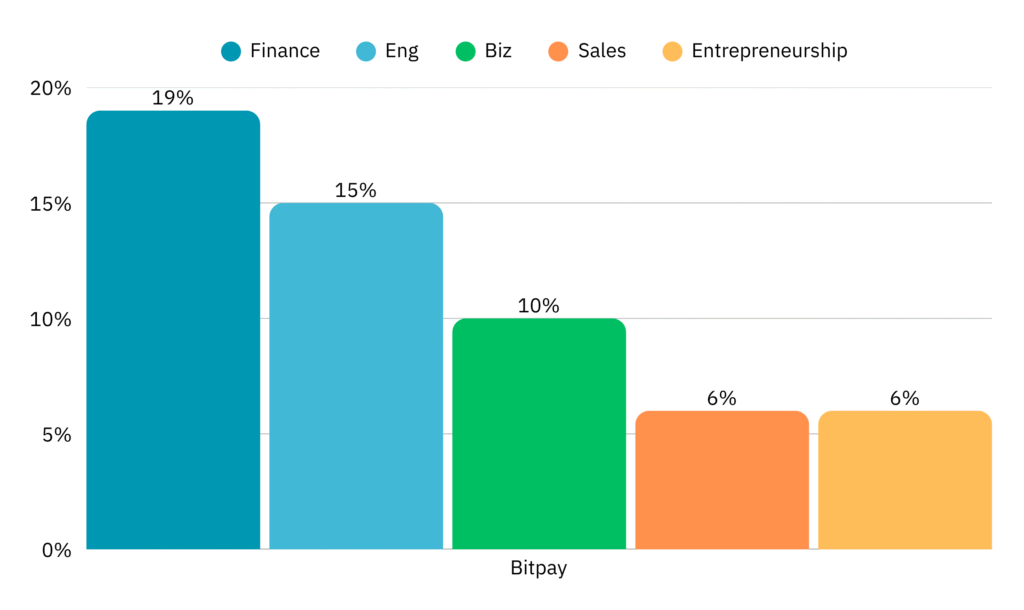
Alchemy Pay
Alchemy Pay operates with one of the leanest teams in the stablecoin enabler space, just 64 employees in total. Unlike larger rivals scaling rapidly, Alchemy is selective about where and how it grows.
Open roles:
- 4 in business development.
- 1 in compliance (AML).
Geography:
- 1 role is based in Lithuania, a hub for its European operations.
- 4 roles are spread across the USA, EU, and Asia.
The functions break down as follows:
- Operations (19%) and Business (16%) are the heaviest areas.
- Marketing (13%) and Engineering (11%) remain secondary.
- Finance (6%) is minimal, consistent with its lean operational model.
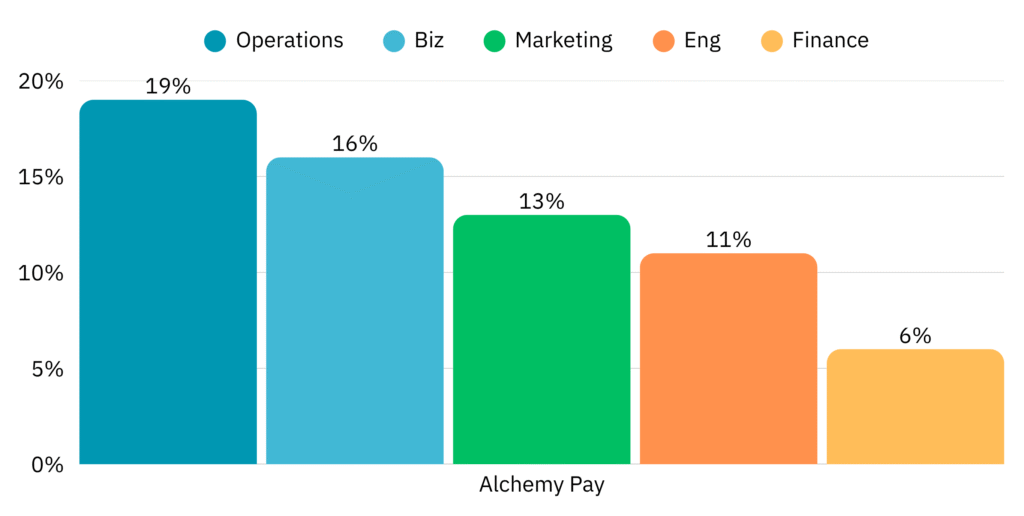
Stablecoin Enablers Compared Across Five Dimensions
Alchemy Pay: Bridging Fiat and Stablecoins in Emerging Markets
Alchemy Pay is building its edge by connecting traditional fiat systems with stablecoin rails. With 3M users, 8M transactions in 2024, and over 1,000 partnerships, it’s grown steadily with a 3x YoY transaction growth. Its GTM strategy is regulatory-first, tailoring local payment rails to ensure compliance while still scaling.
Key partnerships include Ripple (USD support), Visa/Worldpay, and 300+ local wallets & banks, positioning Alchemy Pay as a connector in fragmented emerging markets. Its market expansion is strongest in Southeast Asia, Latin America, and Africa, regions where fiat-stablecoin bridges are in high demand.
MoonPay: From On-Ramp to Global Crypto Payments Network
MoonPay has transitioned from a simple fiat on-ramp to building a global crypto payments network. With 20M+ users, 112% YoY net revenue growth (2025), and a $200M credit line to support liquidity, its growth trajectory is steep.
Its GTM strategy centers on expanding beyond on-ramps to become a payments layer for e-commerce and creators. Key moves include acquiring Helio (6K merchants) and Mesh, while forging deals with PayPal, Venmo, and Mastercard.
Expansion is focused on e-commerce and the creator economy, integrating into platforms like Shopify, Discord, while also eyeing Asia as its next frontier. Organizationally, MoonPay has created a new merchant payments division, hired leadership from Mesh, and is adding compliance staff, API engineers, and partnership managers to scale its infrastructure.
Ramp: Stablecoin Payments for B2B Spend Management
Ramp stands out with a clear B2B focus. Valued at $7.8B (2024), serving 30K+ business clients, and generating $2B+ savings, it has grown rapidly with 730 staff and rising.
Its GTM strategy is unique: combining B2B spend management tools with stablecoin-backed corporate cards. Ramp’s key partnerships include Stripe (stablecoin card issuance) and Shopify (as a client).
Market expansion is staged, first Latin America, then Europe and Africa. To support this, Ramp is hiring heavily into compliance & ops teams, as well as cross-border product engineers, sales, and customer success roles aimed at CFO clients.
Coinbase: Scaling USDC Payments Globally
Coinbase is already the largest player, with 6,204 employees, and is now doubling down on merchant payments through Coinbase Payments (2025). Its growth strategy is about diversifying beyond trading and pushing USDC as a mainstream checkout option.
Its GTM strategy focuses on merchant-friendly rails, with Shopify (millions of merchants) and Stripe for payouts as flagship partners.
Coinbase is expanding in the U.S. and EU, and especially in regions with stablecoin-friendly regulation. Organizationally, it has built a dedicated payments product team (covering smart contracts, checkout UX), and is hiring partnership managers and merchant support staff to scale adoption.
BitPay: The Veteran, Consolidating Instead of Scaling
BitPay, one of the earliest crypto payment processors, now processes 600K+ transactions annually, with stablecoins making up the majority of volume (mainly USDT and USDC).
Its GTM strategy is less aggressive: acting as a gateway for merchants and consumers, focusing on settlement stability rather than rapid expansion.
Partnerships remain strong, including CatalystPay (global online merchants), Verifone (PoS terminals), and PayPal (PYUSD). Market growth is concentrated in Europe and the U.S., while scaling in mainstream retail markets.
Bringing It All Together
These five companies are shaping stablecoin adoption in different ways, from Alchemy Pay’s emerging-market bridges, to MoonPay’s leap into the creator economy, Ramp’s corporate spend platform, Coinbase’s merchant rails, and BitPay’s steady consolidation. Their contrasts become even clearer when we map them across five categories: Business Growth & Focus, GTM Strategy, Key Partnerships, Market Expansion, and Organizational/Team Shifts.
That’s exactly what our radar chart below visualizes, showing where each player is leaning hardest, and where they’re leaving gaps.
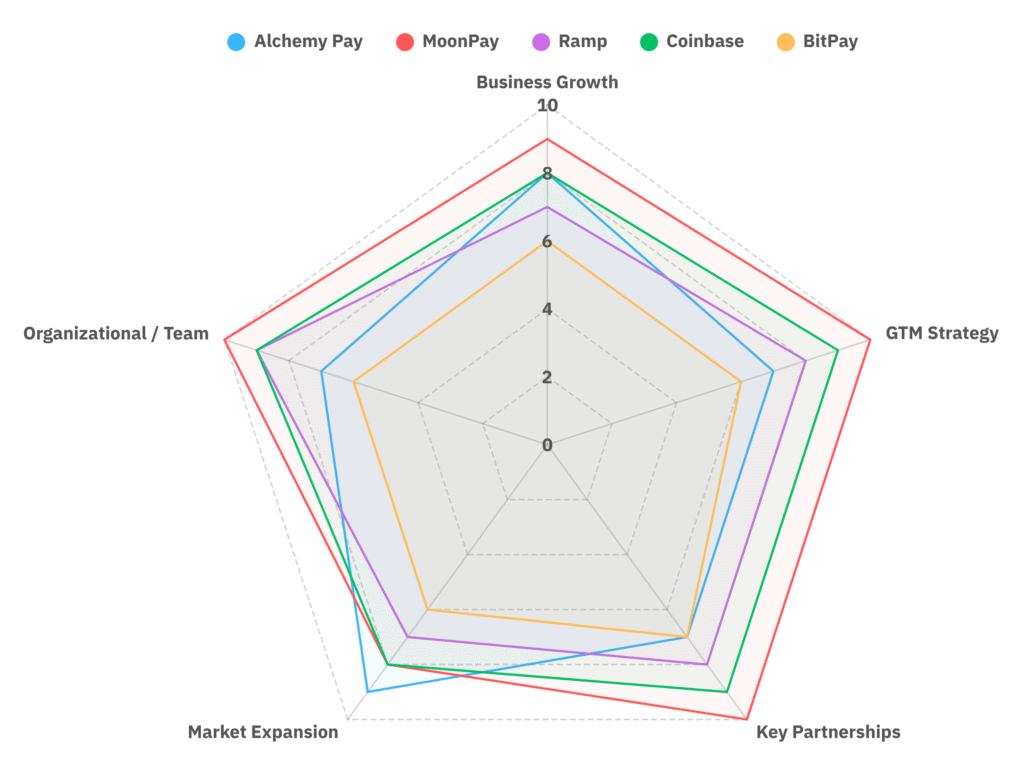
As a final point
Different players are taking different routes: some target emerging markets, others integrate stablecoins into corporate spend, and some push adoption through e-commerce or big payment partnerships. What they share is a simple goal: make stablecoins a practical part of everyday life.
Adoption isn’t going to follow one route. Rules, tech, and local demand will shape how it plays out in each region. But the trend is clear. Every new partnership, license, and hiring move shows stablecoins getting closer to being as normal as using a card or a mobile wallet.
The story is still unfolding, but one thing is certain: the rails we’re building today will determine how fast stablecoins become a standard part of the financial system.





